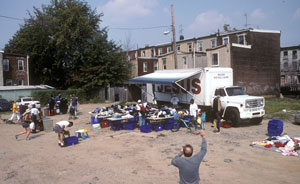talking history | syllabi | students | teachers | puzzle | about us
Invincible Cities
http://invinciblecities.camden.rutgers.edu/
Sponsored by the Mid-Atlantic Regional Center for the Humanities at Rutgers University, Camden, New Jersey.
Reviewed Nov. 2006.
Howard Gillette, the director of the Mid-Atlantic Regional Center for the Humanities, and the photographer Camilo Josť Vergara have collaborated on an interactive Web site entitled Invincible Cities. The site combines short essays by Vergara and an introductory essay on Camden, New Jersey, by Gillette with hundreds of Vergara’s photographs. Vergara is interested in “documenting the evolution of the ghetto over time” in order to demonstrate that the “declining inner city” is an inadequate framework for understanding the “flux” of America’s urban landscape. The site takes Camden and Richmond, California, as visual laboratories for the exploration of patterns in the built environment. Street maps on the left of the screen allow the user to pan to specific neighborhoods and blocks, while photographs on the right of the screen (some in time sequence over a period of years) record the buildings, parks, brown fields, and streetscapes of those spaces. The effect is a multilayered archaeology of the modern city, from its densely packed street markets and its recycled strip malls to its patchwork of abandoned properties, boarded storefronts, and aging row houses.

Neighborhood life in Camden.
The accompanying essays offer a range of interpretive possibilities, which invite the viewer not simply to gaze but to reflect. Vergara notes, for instance, that his time sequences of certain Camden neighborhoods reveal that redevelopment is often accompanied by the elimination of large shade trees. Blocks become hotter and less inviting as a result. Older buildings have become fortresses as their windows are boarded up, their faces turned inward away from the street. Gillette hopes that Invincible Cities can assist in the careful recovery of Camden and Richmond by “allowing a range of interested parties—scholars, journalists, and other nonresidents—to see the city for themselves.” This is imperative for Camden, Gillette argues, because revitalization efforts under 2001 state legislation have yet to produce a viable community-centered plan that promises more than gentrification. Together, Vergara and Gillette have positioned Invincible Cities as an arresting intervention both in the conceptual schemes middle-class Americans employ to imagine urban spaces and in the redevelopment plans that emerge from top-down planning processes.
A fair question remains, however: Will it work? Camden and Richmond are both aging industrial satellites (of Philadelphia and San Francisco, respectively) rather than “inner cities.” The photographs of them here are wonderful: alternately haunting, personal, bracing, and hopeful. People carve out complex lives and adapt the built environment with ingenious improvisation, even amid great poverty and institutional indifference. At the same time, the photographs do not speak the language of developers, real estate interests, and city councils. They do record: resilience; small moments of great and touching beauty; the physical detritus of urban neglect. But one worries that this language, while moving to the artist and humanist in us, remains either silent or, perhaps worse, irrelevant to the capitalist and politician in us. Moreover, there remains the possibility that the site, despite its creators' noble intentions, will become an artifact of the bourgeois gaze, content to look at but remain distant from the reality of urban life. I hope that Gillette’s and Vergara’s ambitions for the site are realized. It is as creative and fascinating a tool for navigating urban space as I have seen on the World Wide Web. I am less confident, at least in our current moment, that its political possibilities will be sufficiently embraced.
Robert O. Self
Brown University
Providence, Rhode Island
